-
The forum has been upgraded to support both light and dark themes. Click here for directions.
You are using an out of date browser. It may not display this or other websites correctly.
You should upgrade or use an alternative browser.
You should upgrade or use an alternative browser.
The Year of The Oaks
- Thread starter Native Hunter
- Start date
-
- Tags
- oak
shedder
Active Member
FYI Some Facebook comments that may be of interest.
https://m.facebook.com/story.php?story_fbid=574884717231553&id=112192323500797
We post photos of young trees grown directly in place from seed that have grown so fast and are so healthy, that readers question whether they are real. This is understandable The swamp chestnut oak in the photo is 20 years old, very healthy, 15 inches in diameter and 45 feet tall. Most of urban and residential trees are abused and neglected, so we are not accustomed to seeing trees that are treated well.
Here is how to grow large, fast growing, healthy trees from seed:
1. Stop mowing the place the tree will grow, a year or more in advance. Trees grow poorly in compacted soil. Cease treating the grass with herbicides.
2. At least six months in advance, mulch the planting site thickly with grass clippings, straw, or leaf mold to smother the grass and weeds in a circle about 5 feet in diameter.
3. Select seed of a tree species that is well suited to the soil and site conditions. If you don't know how to assess species-to-site relationships, get advice from a trained forester. Planting a species well suited to the site is extremely important. Don't plant a tree just because it is a kind you like. Instead, plant a species that will grow well on your site.
4. Using white oak planted in September as an example, pull the mulch back to bare ground. Loosen the soil about 2 inches deep. Press about 12 acorns into the surface of the soil, very shallow.
5. Place a very light layer of leaf mold over the seeds.
6. Protect the seeds with Droste cans, tree tubes, or tight fencing.
7. Mulch the area of smothered grass with a thin layer of leaf mold mulch. Light weight leaf mold mulch is superior to heavy commercial woodchip mulch.
8. Several seedlings will appear in late April or early May. Be patient.
9. Keep at least three seedlings the first season.
10. DO NOT attempt to transplant the extra seedlings. Cut them off at ground level
11. Water the young seedlings in dry weather.
12. Lightly mulch a 5 foot circle around the seedlings using a mixture of leaf mold and untreated grass clippings. Very light layers can be added during Summer and Fall. Pull weeds by hand.
13. Under no circumstance allow lawn mowers or other heavy vehicles cross the mulched areas. Soil compaction is the unseen, unrecognized enemy of young tree roots.
14. Maintain the protective fencing.
15. During the second season, very light fertilizing can begin. Perhaps the equivalent of a table spoon of 12-12-12 twice a Summer. Water in dry weather.
16. At the beginning of the 3rd season thin to the strongest sapling. Again, do not attempt to transplant the saplings. Cut the excess saplings at the soil surface. If they resprout, cut them again.
17. In the 3rd season, fertilizer can be applied at slightly greater rates. Spread it thinnly and evenly on the mulched area, bit not against the trunk.
18. If deer are a threat, higher fencing may be needed.
19. Continue to keep lawnmowers away from the planting site. Root and soil damage do far more harm than we realize.
20. Watering can be done in dry weather.
21. In the third Winter, judicious pruning of lower branches can begin. If you are not skilled in pruning, get help or advice from.a certified arborist. Early training is far more valuable than expensive, corrective pruning of older trees.
22. In successive years, continue light mulching with leafmold-grass clipping mixtures. Light layers can be added at regular intervals, never very thick and never up against the trunk of the tree.
23. Fencing can be removed at 4 or 5 inches in diameter.
24. Watering as needed and light fertilization should continue.
25. Regular, little at a time pruning should continue. Get advice or help from your arborist.
26. Keep mowers and heavy equipment away from the drip edge of the tree for the next 500 years.
https://m.facebook.com/story.php?story_fbid=574884717231553&id=112192323500797
We post photos of young trees grown directly in place from seed that have grown so fast and are so healthy, that readers question whether they are real. This is understandable The swamp chestnut oak in the photo is 20 years old, very healthy, 15 inches in diameter and 45 feet tall. Most of urban and residential trees are abused and neglected, so we are not accustomed to seeing trees that are treated well.
Here is how to grow large, fast growing, healthy trees from seed:
1. Stop mowing the place the tree will grow, a year or more in advance. Trees grow poorly in compacted soil. Cease treating the grass with herbicides.
2. At least six months in advance, mulch the planting site thickly with grass clippings, straw, or leaf mold to smother the grass and weeds in a circle about 5 feet in diameter.
3. Select seed of a tree species that is well suited to the soil and site conditions. If you don't know how to assess species-to-site relationships, get advice from a trained forester. Planting a species well suited to the site is extremely important. Don't plant a tree just because it is a kind you like. Instead, plant a species that will grow well on your site.
4. Using white oak planted in September as an example, pull the mulch back to bare ground. Loosen the soil about 2 inches deep. Press about 12 acorns into the surface of the soil, very shallow.
5. Place a very light layer of leaf mold over the seeds.
6. Protect the seeds with Droste cans, tree tubes, or tight fencing.
7. Mulch the area of smothered grass with a thin layer of leaf mold mulch. Light weight leaf mold mulch is superior to heavy commercial woodchip mulch.
8. Several seedlings will appear in late April or early May. Be patient.
9. Keep at least three seedlings the first season.
10. DO NOT attempt to transplant the extra seedlings. Cut them off at ground level
11. Water the young seedlings in dry weather.
12. Lightly mulch a 5 foot circle around the seedlings using a mixture of leaf mold and untreated grass clippings. Very light layers can be added during Summer and Fall. Pull weeds by hand.
13. Under no circumstance allow lawn mowers or other heavy vehicles cross the mulched areas. Soil compaction is the unseen, unrecognized enemy of young tree roots.
14. Maintain the protective fencing.
15. During the second season, very light fertilizing can begin. Perhaps the equivalent of a table spoon of 12-12-12 twice a Summer. Water in dry weather.
16. At the beginning of the 3rd season thin to the strongest sapling. Again, do not attempt to transplant the saplings. Cut the excess saplings at the soil surface. If they resprout, cut them again.
17. In the 3rd season, fertilizer can be applied at slightly greater rates. Spread it thinnly and evenly on the mulched area, bit not against the trunk.
18. If deer are a threat, higher fencing may be needed.
19. Continue to keep lawnmowers away from the planting site. Root and soil damage do far more harm than we realize.
20. Watering can be done in dry weather.
21. In the third Winter, judicious pruning of lower branches can begin. If you are not skilled in pruning, get help or advice from.a certified arborist. Early training is far more valuable than expensive, corrective pruning of older trees.
22. In successive years, continue light mulching with leafmold-grass clipping mixtures. Light layers can be added at regular intervals, never very thick and never up against the trunk of the tree.
23. Fencing can be removed at 4 or 5 inches in diameter.
24. Watering as needed and light fertilization should continue.
25. Regular, little at a time pruning should continue. Get advice or help from your arborist.
26. Keep mowers and heavy equipment away from the drip edge of the tree for the next 500 years.
Attachments
Native Hunter
Well-Known Member
As soon as the leaves mature on my trees we will get this thread cranked back up. The late freeze fried a lot of leaves, so it may be a few weeks.
Native Hunter
Well-Known Member
Black Oak - Quercus velutina
I’m going to get started back with an oak from the Red Oak Family - Black Oak - Quercus velutina. This is a tree that is fairly easy to identify among the red oaks. Some facts and features:
· I estimate that maybe 5% - 10% of my red oak family trees are Black Oak. I didn’t order these but glad to have a few in the mix.
· The bark is very dark (almost black).
· The bark is very high in tannin. Black Oak has been used as a source of tannin for industrial purposes.
· The leaves are highly variable, but somewhat resemble the leaves of Northern Red Oak.
· You can chip away some of the outer bark and see an orangish or yellowish color underneath. I have a picture below of this. This is caused by the high tannin content.
· Black Oak tends to have somewhat more of a tapered bole than most other red oak family member. This is not extremely prominent, but it is noticible.
· There is nothing really special about the acorns in terms of deer, but they are probably about average in terms of preference for the red oak family.
· I like having several Black Oaks due to the diversity that they add to the planting.
· They are growing almost as fast as Pin Oak, but not quite as much in my damp soil. I’m seeing some Black Oaks that are over 40 feet tall and 12 + inches at the base. Even though they normally grow in drier soils, they are adapting well to my location.
Here is a good link from UK: Black Oak | Department of Horticulture (uky.edu)
Another good link: Black Oak, QUERCUS VELUTINA (backyardnature.net)
In the picture below, note the orangish coloration under the outer bark, which indicates the high tannin content of this species:
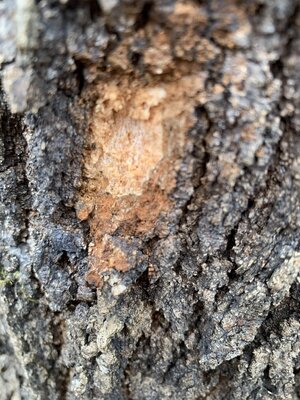
In the next picture, you see a Black Oak of about average size in my planting. I would estimate this one 40+ feet tall.
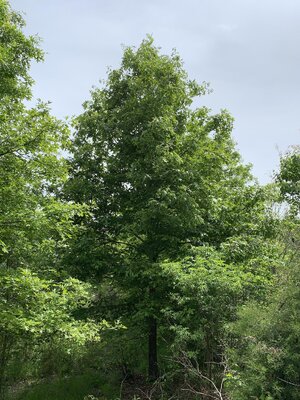
Another big one at the edge of the planting:
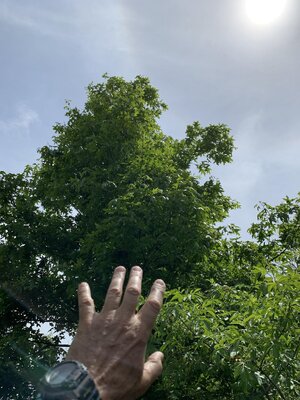
This is a picture of the bark. Some of the trees are even blacker than this one. You can somewhat see the tapering of the bole
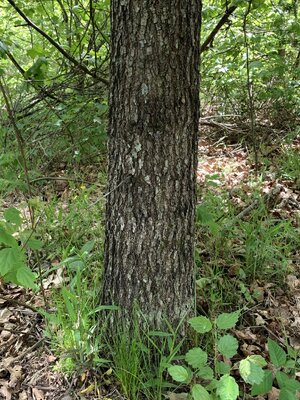
Some Leaves:
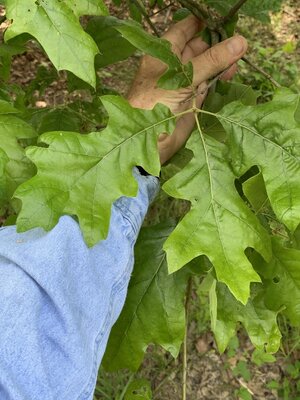
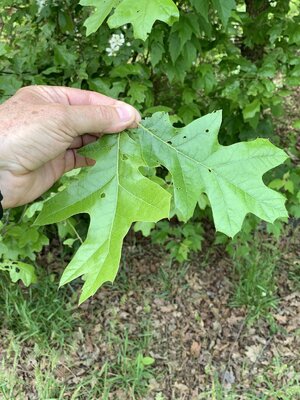
That’s about it for Black Oak guys. I will post up another species in a few days. Take Care……
I’m going to get started back with an oak from the Red Oak Family - Black Oak - Quercus velutina. This is a tree that is fairly easy to identify among the red oaks. Some facts and features:
· I estimate that maybe 5% - 10% of my red oak family trees are Black Oak. I didn’t order these but glad to have a few in the mix.
· The bark is very dark (almost black).
· The bark is very high in tannin. Black Oak has been used as a source of tannin for industrial purposes.
· The leaves are highly variable, but somewhat resemble the leaves of Northern Red Oak.
· You can chip away some of the outer bark and see an orangish or yellowish color underneath. I have a picture below of this. This is caused by the high tannin content.
· Black Oak tends to have somewhat more of a tapered bole than most other red oak family member. This is not extremely prominent, but it is noticible.
· There is nothing really special about the acorns in terms of deer, but they are probably about average in terms of preference for the red oak family.
· I like having several Black Oaks due to the diversity that they add to the planting.
· They are growing almost as fast as Pin Oak, but not quite as much in my damp soil. I’m seeing some Black Oaks that are over 40 feet tall and 12 + inches at the base. Even though they normally grow in drier soils, they are adapting well to my location.
Here is a good link from UK: Black Oak | Department of Horticulture (uky.edu)
Another good link: Black Oak, QUERCUS VELUTINA (backyardnature.net)
In the picture below, note the orangish coloration under the outer bark, which indicates the high tannin content of this species:

In the next picture, you see a Black Oak of about average size in my planting. I would estimate this one 40+ feet tall.

Another big one at the edge of the planting:

This is a picture of the bark. Some of the trees are even blacker than this one. You can somewhat see the tapering of the bole

Some Leaves:


That’s about it for Black Oak guys. I will post up another species in a few days. Take Care……
Last edited:
dogghr
Well-Known Member
Good read Native. Black oaks are an ugly tree compared to most others. But they love high , dry , rocky ridges so obviously my ridgetops and south slopes have pretty good crop of them. Extremely drought resistant. A lot of mine are 75+ yo.
What is nice about them is they hardly ever fail acorn production. Also since deer like other acorns better , they tend to lay and be eaten late season which makes DecJan great places to hunt.
One caution. They presently are a very diseased tree in the east and many are hollow. So when cutting one need really pay attention to the chainsaw chips.
In addition they tend to split and rocking chair so hinge cutting is tricky. I cut them all the time but they make me nervous. Only tree that has given me close calls several times.
Thanks for the info.
Sent from my iPhone using Tapatalk
What is nice about them is they hardly ever fail acorn production. Also since deer like other acorns better , they tend to lay and be eaten late season which makes DecJan great places to hunt.
One caution. They presently are a very diseased tree in the east and many are hollow. So when cutting one need really pay attention to the chainsaw chips.
In addition they tend to split and rocking chair so hinge cutting is tricky. I cut them all the time but they make me nervous. Only tree that has given me close calls several times.
Thanks for the info.
Sent from my iPhone using Tapatalk
Native Hunter
Well-Known Member
Good read Native. Black oaks are an ugly tree compared to most others. But they love high , dry , rocky ridges so obviously my ridgetops and south slopes have pretty good crop of them. Extremely drought resistant. A lot of mine are 75+ yo.
What is nice about them is they hardly ever fail acorn production. Also since deer like other acorns better , they tend to lay and be eaten late season which makes DecJan great places to hunt.
One caution. They presently are a very diseased tree in the east and many are hollow. So when cutting one need really pay attention to the chainsaw chips.
In addition they tend to split and rocking chair so hinge cutting is tricky. I cut them all the time but they make me nervous. Only tree that has given me close calls several times.
Thanks for the info.
Sent from my iPhone using Tapatalk
That’s some great observations dogghr. Thanks for sharing your first hand knowledge.
Last edited:
Native Hunter
Well-Known Member
Native Hunter
Well-Known Member
Pin Oak - Quercus palustris
Today we will look at Pin Oaks, which are another Red Oak Family species that is easy to identify. Some facts and features:
· This species is probably familiar to many people because of how extensively it has been used in landscaping. The beautiful form and drooping branches have made it very popular.
· Pin Oaks are easily transplanted due to their shallow root systems.
· They are extremely fast growers. They put on a lot of height each year. Some of my trees are 60+ feet tall in 17 years.
· Pin Oaks are not native on my farm. Before my tree planting, I had never seen one in the wild. However, the soil seems to be very well suited for them. My location is within the native range of the tree, but near the edge of the range.
· They prefer areas with hydric soils like much of my planting is. However, they are very adaptable and will grow in a wide variety of soils.
· I estimate that probably 10% - 20% of my red oak family trees are Pin Oaks.
· You will find varying information on the Internet about the preference of Pin Oak acorns for deer. Some people rate them at the top and very high on the list for Red Oak acorns, but others rate them lower. This is likely due to regional differences and the availability of other foods more than anything else.
· Pin Oak is not a great lumber tree due to the knottiness of the wood and a tendency to warp. However, it is a great wildlife tree for both cover and food.
· Here is the USDA link for Pin Oak: Quercus palustris Muenchh (usda.gov)
· Here is another good link: Pin Oak | Department of Horticulture (uky.edu)
Here is a picture of a big one out in the planting a few yards. This tree looks to me to be at least 65 feet tall, if not taller:
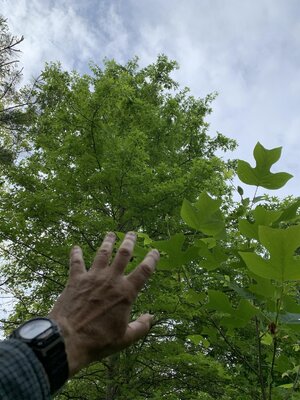
This is the base of that tree:
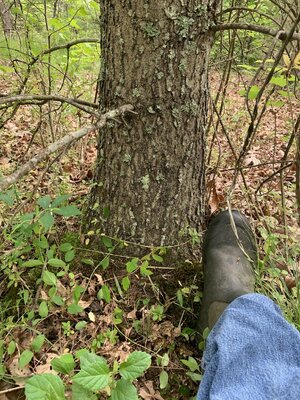
Note the dead limbs that have been shaded out but still hanging on. This is typical of Pin Oak:
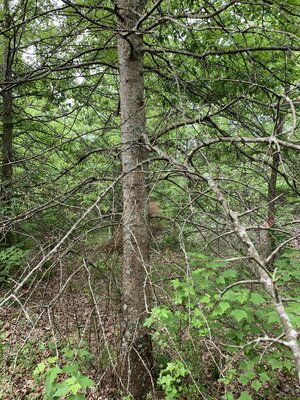
Here is a short and wide one at the edge of the planting that hangs out over a spot where I had a food plot last fall. The deer started making scrapes under this tree, and the next thing I knew, there was a scrape that was 12 feet long, where they all joined together:
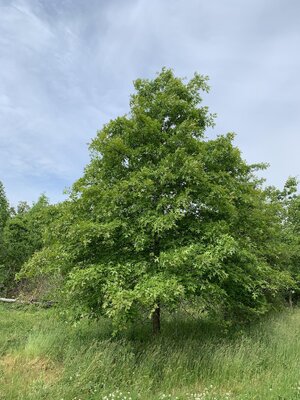
Leaves of Pin Oak:
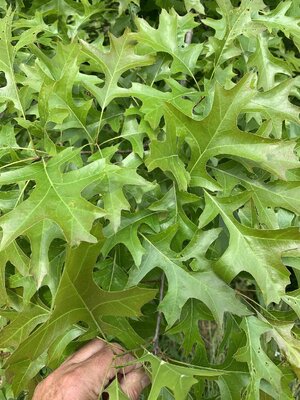
That’s about it for Pin Oak. Another species to come in a few days. However, today you get some bonus pictures. I couldn’t help but contrast the huge shade leaves (15 inches long) on one of my Bur Oaks with the Overcup Oak that is just now barely beginning to make leaves. The two pictures below were taken on the same day of 5-19-21. Enjoy.
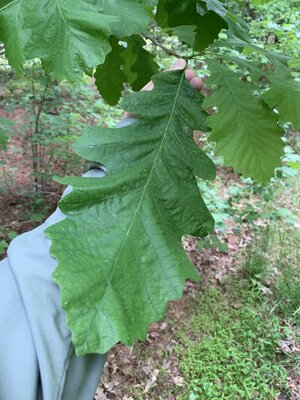
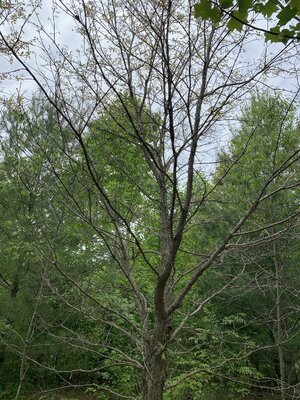
Today we will look at Pin Oaks, which are another Red Oak Family species that is easy to identify. Some facts and features:
· This species is probably familiar to many people because of how extensively it has been used in landscaping. The beautiful form and drooping branches have made it very popular.
· Pin Oaks are easily transplanted due to their shallow root systems.
· They are extremely fast growers. They put on a lot of height each year. Some of my trees are 60+ feet tall in 17 years.
· Pin Oaks are not native on my farm. Before my tree planting, I had never seen one in the wild. However, the soil seems to be very well suited for them. My location is within the native range of the tree, but near the edge of the range.
· They prefer areas with hydric soils like much of my planting is. However, they are very adaptable and will grow in a wide variety of soils.
· I estimate that probably 10% - 20% of my red oak family trees are Pin Oaks.
· You will find varying information on the Internet about the preference of Pin Oak acorns for deer. Some people rate them at the top and very high on the list for Red Oak acorns, but others rate them lower. This is likely due to regional differences and the availability of other foods more than anything else.
· Pin Oak is not a great lumber tree due to the knottiness of the wood and a tendency to warp. However, it is a great wildlife tree for both cover and food.
· Here is the USDA link for Pin Oak: Quercus palustris Muenchh (usda.gov)
· Here is another good link: Pin Oak | Department of Horticulture (uky.edu)
Here is a picture of a big one out in the planting a few yards. This tree looks to me to be at least 65 feet tall, if not taller:

This is the base of that tree:

Note the dead limbs that have been shaded out but still hanging on. This is typical of Pin Oak:

Here is a short and wide one at the edge of the planting that hangs out over a spot where I had a food plot last fall. The deer started making scrapes under this tree, and the next thing I knew, there was a scrape that was 12 feet long, where they all joined together:

Leaves of Pin Oak:

That’s about it for Pin Oak. Another species to come in a few days. However, today you get some bonus pictures. I couldn’t help but contrast the huge shade leaves (15 inches long) on one of my Bur Oaks with the Overcup Oak that is just now barely beginning to make leaves. The two pictures below were taken on the same day of 5-19-21. Enjoy.


Last edited:
Native Hunter
Well-Known Member
This guy on Facebook has interesting things to say about black oaks and other oaks.
He says black oak tend to be leaners in his woods because of competition he thinks. They shade out over time.
Interesting..... I haven't seen that in my neck of the woods, but I will keep my eyes open....
Native Hunter
Well-Known Member
Post Oak (Quercus stellate)
Even though I didn’t order any, I ended up with a few post oaks in my planting. This is a species that is very much native to our area, and one I have seen before many times in the surrounding countryside. It’s a member of the White Oak Family, and here are a few facts and observations:
· Post Oak acorns are low in tannin, which makes them desirable to deer. They are also smaller than regular white oak acorns, which make them attractive to turkeys as well.
· Post Oak acorns generally fall just a little later than regular white oak acorns. After the white oaks are gone, a good post oak can be a great place to find a deer feeding.
· Post Oak is a medium sizes tree. In the southeast, the species generally gets 50-60 feet tall; therefore, it can be shaded out by taller species. The best one I have found is at the edge of my planting where there is no danger of it being shaded out..
· Post Oak generally grows on dry sites.
· The tree exhibits marcescence – holding dead leaves most of the winter.
· Here is the USDA link for the species: Quercus stellata Wangenh (usda.gov)
Here are the leaves on one of my trees:

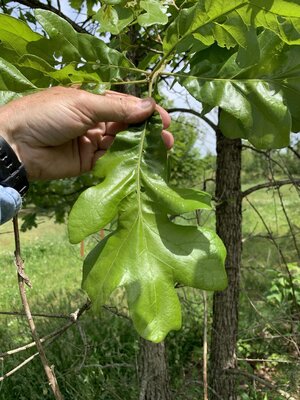
This was the same tree back in the winter. You can see how it is holding on to the dead leaves:
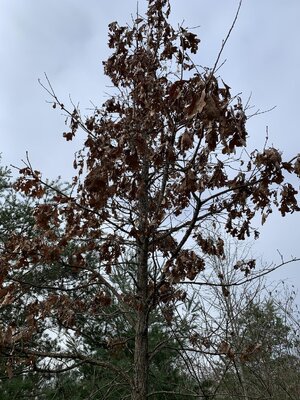
Here is the same tree recently:
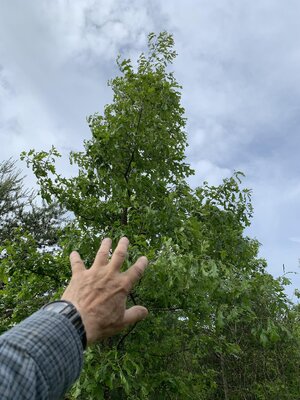
And here is the bark:
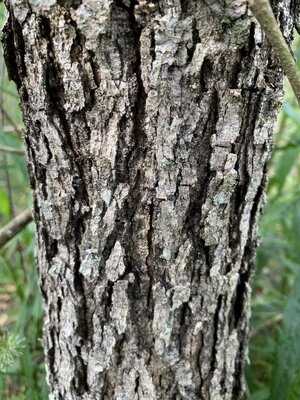
That’s about it for Post Oak. Stay tuned and we will sniff out another oak soon.
Even though I didn’t order any, I ended up with a few post oaks in my planting. This is a species that is very much native to our area, and one I have seen before many times in the surrounding countryside. It’s a member of the White Oak Family, and here are a few facts and observations:
· Post Oak acorns are low in tannin, which makes them desirable to deer. They are also smaller than regular white oak acorns, which make them attractive to turkeys as well.
· Post Oak acorns generally fall just a little later than regular white oak acorns. After the white oaks are gone, a good post oak can be a great place to find a deer feeding.
· Post Oak is a medium sizes tree. In the southeast, the species generally gets 50-60 feet tall; therefore, it can be shaded out by taller species. The best one I have found is at the edge of my planting where there is no danger of it being shaded out..
· Post Oak generally grows on dry sites.
· The tree exhibits marcescence – holding dead leaves most of the winter.
· Here is the USDA link for the species: Quercus stellata Wangenh (usda.gov)
Here are the leaves on one of my trees:


This was the same tree back in the winter. You can see how it is holding on to the dead leaves:

Here is the same tree recently:

And here is the bark:

That’s about it for Post Oak. Stay tuned and we will sniff out another oak soon.
Last edited:
Native Hunter
Well-Known Member
Do you have any blackjack oaks up that way Native?
Yes we do. I noticed one the other day at my branch, but I haven’t found any in my planting yet.
Last edited:
Native Hunter
Well-Known Member
Cherry Bark Oak - Quercus pagoda
This is an oak that I have several of in my planting. I would estimate between 15% and 25% of my red oak family trees are this species. Let’s look at some facts:
· This species can get very tall. Trees over 130 feet tall are not uncommon. Some of the 17 year old trees in my planting appear to be over 70 feet tall – and I am a decent judge of height due to working around utility poles all my life.
· This species is not native to my area, but it is adapted very well to my land.
· It has a reputation of producing a good crop most years with heavy crops every 3 or 4 years.
· Acorns are somewhat on the small size for the red oak family but very desirable to deer and turkey. Acorns drop in November.
· It grows best in well drained bottomland sites but can adapt to other soil conditions. It can withstand flooding for short periods of time.
· The timber of this species is highly prized – one of the most sought after red oaks.
· See picture and notes below on how the leaf undersides can help identify this species.
· Here is a good picture of the acorns on the Mossy Oak site: Cherrybark Oak Seedlings for Sale (Quercus pagoda) – Nativ Nurseries
· USDA Link: Quercus falcata (fs.fed.us)
This is a picture of the bark of the tree. Notice how it resembles the bark of a wild cherry.

Many of these trees are already over 60+ feet tall in my planting. They really reach for the sky. Below is a picture of one and you can see how it is 20 feet taller than the nearby white pine that was planted at the same time. I think this tree must be closer to 7o feet tall:
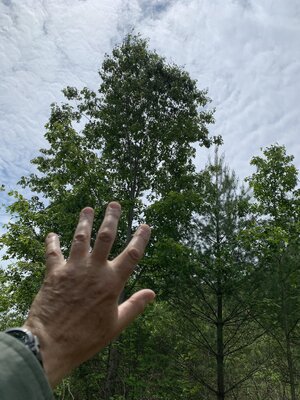
Here is another one near a white pine and the two trees are essentially the same height:
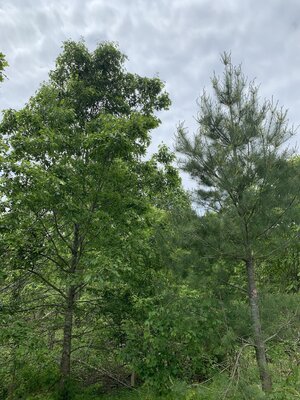
Here are some leaves. The only leaves I was able to reach were some low ones in the shade. The shade leaves are much blockier than the sun leaves.
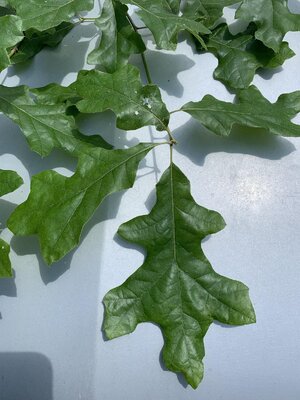
A distinguishing characteristic of Cherry Bark Oak is the dense and fine hairs (pubescence) on its leaf undersides. Other species in the Red Oak group (Except for Spanish Oak) have either slick undersides or their hairs are only at the junctions of major veins on their leaf undersides. The hairy undersides are hard to see in my pics below, but you can easily feel it when you run against your face.


That’s about it for Cherry Bark Oak. Bonus picture today is a patch of blackberry blooming at the edge of the tree planting – yum, yum…berries and acorns…..
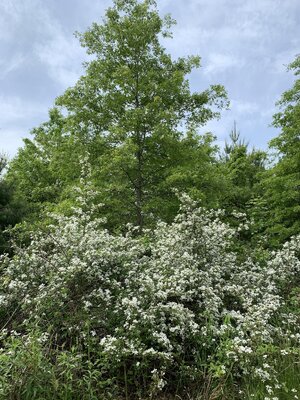
This is an oak that I have several of in my planting. I would estimate between 15% and 25% of my red oak family trees are this species. Let’s look at some facts:
· This species can get very tall. Trees over 130 feet tall are not uncommon. Some of the 17 year old trees in my planting appear to be over 70 feet tall – and I am a decent judge of height due to working around utility poles all my life.
· This species is not native to my area, but it is adapted very well to my land.
· It has a reputation of producing a good crop most years with heavy crops every 3 or 4 years.
· Acorns are somewhat on the small size for the red oak family but very desirable to deer and turkey. Acorns drop in November.
· It grows best in well drained bottomland sites but can adapt to other soil conditions. It can withstand flooding for short periods of time.
· The timber of this species is highly prized – one of the most sought after red oaks.
· See picture and notes below on how the leaf undersides can help identify this species.
· Here is a good picture of the acorns on the Mossy Oak site: Cherrybark Oak Seedlings for Sale (Quercus pagoda) – Nativ Nurseries
· USDA Link: Quercus falcata (fs.fed.us)
This is a picture of the bark of the tree. Notice how it resembles the bark of a wild cherry.

Many of these trees are already over 60+ feet tall in my planting. They really reach for the sky. Below is a picture of one and you can see how it is 20 feet taller than the nearby white pine that was planted at the same time. I think this tree must be closer to 7o feet tall:

Here is another one near a white pine and the two trees are essentially the same height:

Here are some leaves. The only leaves I was able to reach were some low ones in the shade. The shade leaves are much blockier than the sun leaves.

A distinguishing characteristic of Cherry Bark Oak is the dense and fine hairs (pubescence) on its leaf undersides. Other species in the Red Oak group (Except for Spanish Oak) have either slick undersides or their hairs are only at the junctions of major veins on their leaf undersides. The hairy undersides are hard to see in my pics below, but you can easily feel it when you run against your face.


That’s about it for Cherry Bark Oak. Bonus picture today is a patch of blackberry blooming at the edge of the tree planting – yum, yum…berries and acorns…..

Last edited:
Native Hunter
Well-Known Member
Northern Red Oak - Quercus rubra
This is an oak that I have several of in my planting. I would estimate between 15% and 25% of my red oak family trees are this species. This oak is native to my area, and I was already familiar with the species before adding it to my planting. Let’s look at some facts:
· This species is generally found in the wild in upland woods, drier areas of floodplains and high riverbanks.
· The species is a highly valued timber tree that grows over 100 feet tall on good ground.
· The tree transplants easily, and is a popular addition to many CRP plantings.
· The leaves are less deeply lobed than many other members of the red oak group. When its leaves are exposed to the sun, its stems often have a reddish cast.
· NRO has large acorns with shallow cups that are highly prized by deer and other wildlife.
· On my land it has grown very well but not quite as tall as Pin Oak or Cherrybark Oak.
· Here is the USDA link: Quercus rubra L (usda.gov)
· Here is a good link for telling the difference between Northern and Southern Red Oak: Northern Red Oak vs Southern Red Oak: Identification - bplant.org
Here are some leaf pictures. Note the light green color and reddish cast on some of the leaves.
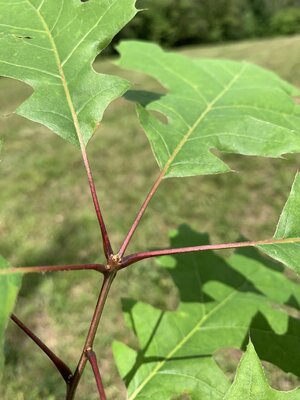

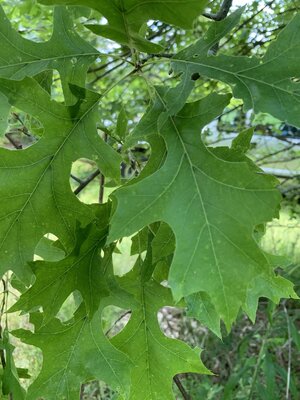
Here is what the bark looks like in trees the age of mine. The bark tends to change with age:
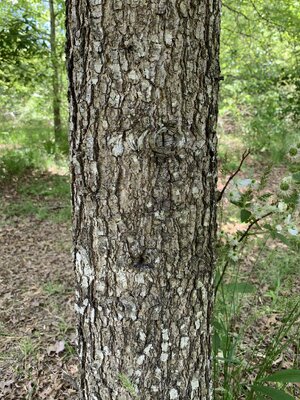
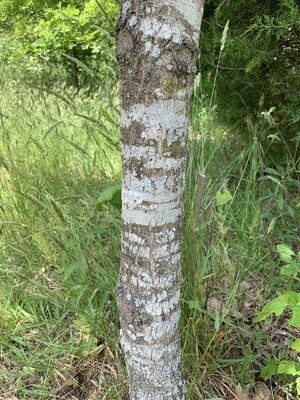
Here are some typical trees. They are tall, but haven’t quite grown to the height of the Cherrybark Oaks.
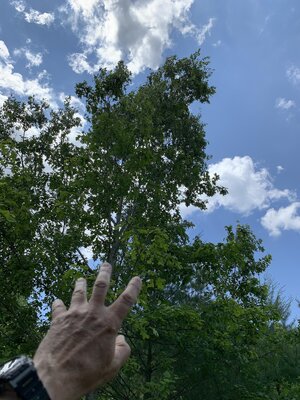
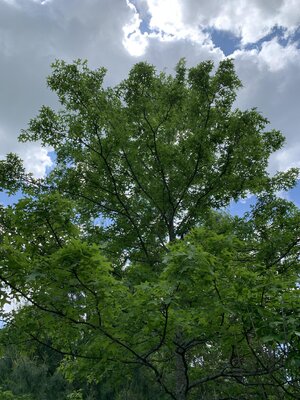
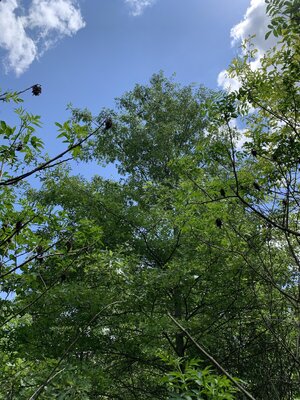
That’s it for Northern Red Oak. Another species coming soon.
This is an oak that I have several of in my planting. I would estimate between 15% and 25% of my red oak family trees are this species. This oak is native to my area, and I was already familiar with the species before adding it to my planting. Let’s look at some facts:
· This species is generally found in the wild in upland woods, drier areas of floodplains and high riverbanks.
· The species is a highly valued timber tree that grows over 100 feet tall on good ground.
· The tree transplants easily, and is a popular addition to many CRP plantings.
· The leaves are less deeply lobed than many other members of the red oak group. When its leaves are exposed to the sun, its stems often have a reddish cast.
· NRO has large acorns with shallow cups that are highly prized by deer and other wildlife.
· On my land it has grown very well but not quite as tall as Pin Oak or Cherrybark Oak.
· Here is the USDA link: Quercus rubra L (usda.gov)
· Here is a good link for telling the difference between Northern and Southern Red Oak: Northern Red Oak vs Southern Red Oak: Identification - bplant.org
Here are some leaf pictures. Note the light green color and reddish cast on some of the leaves.



Here is what the bark looks like in trees the age of mine. The bark tends to change with age:


Here are some typical trees. They are tall, but haven’t quite grown to the height of the Cherrybark Oaks.



That’s it for Northern Red Oak. Another species coming soon.
Last edited:
shedder
Active Member
Northern Red Oak - Quercus rubra
This is an oak that I have several of in my planting. I would estimate between 15% and 25% of my red oak family trees are this species. This oak is native to my area, and I was already familiar with the species before adding it to my planting. Let’s look at some facts:
· This species is generally found in the wild in upland woods, drier areas of floodplains and high riverbanks.
· The species is a highly valued timber tree that grows over 100 feet tall on good ground.
· The tree transplants easily, and is a popular addition to many CRP plantings.
· The leaves are less deeply lobed than many other members of the red oak group. When its leaves are exposed to the sun, its stems often have a reddish cast.
· NRO has large acorns with shallow cups that are highly prized by deer and other wildlife.
· On my land it has grown very well but not quite as tall as Pin Oak or Cherrybark Oak.
· Here is the USDA link: Quercus rubra L (usda.gov)
· Here is a good link for telling the difference between Northern and Southern Red Oak: Northern Red Oak vs Southern Red Oak: Identification - bplant.org
Here are some leaf pictures. Note the light green color and reddish cast on some of the leaves.



Here is what the bark looks like in trees the age of mine. The bark tends to change with age:


Here are some typical trees. They are tall, but haven’t quite grown to the height of the Cherrybark Oaks.



That’s it for Northern Red Oak. Another species coming soon.
That doesn't look like rubra bark here. It is smooth like beech when young and ridgy when older.
Native Hunter
Well-Known Member
That doesn't look like rubra bark here. It is smooth like beech when young and ridgy when older.
You will notice that I showed 2 pictures of bark, and they are very different. One is a smaller tree that is still somewhat smooth like beech, and the second one is a larger tree that is beginning to develop the ridges. Please note that the two look very different and go along with what you said. If I had taken a picture out in the mature forest you would see the "ski track" ridges developed more deeply.
Last edited:
TX-Aggie
Active Member
Enjoying this thread - my farm in the ozark mountains have a lot of these oaks you are talking about. A couple of observations that may help some :
-Our white oak species (mainly White Oak, Swamp White Oaks, and a few Swamp Chestnut Oaks i believe - my grandfather called them cow oaks) grow where the soil is the deepest on the farm - the bottom land and hill side benches, rarely any where else. my grandfather's saying was "if you see a white oak, you have good dirt there".
-Our Red Oaks (mainly black oaks and blackjack oaks, some plain jane red oaks) grow up on the ridge tops and steeper side hills.
-The Chinkapin Oaks grow in both the deeper soils in the bottoms and shallower soiled ridge tops, but not so much on the steeper side hills. The Chinkapin oaks are typically taller than the Red Oaks when growing near each other, but about the same overall height as the white oaks in the bottoms.
-The Dwarf Chinkapin Oaks grow on the thin ridge top soil that also have rock outcrops. These trees that I have "self-identified" have grown about 15-20 feet tall max, and form a what we in texas refer to as a "motte" style cluster (not to steal doggr's random clusters idea). They have been the same size for probably the last 10 years or so - didn't know what they were until recently from this forum.
As for which one is best for wildlife, the chinkapin and dwark chinkapin are the winners here. when they are dropping, the deer and turkey flood the area until the acorns are gone. My dad had a friend send him game pictures of a tom and small buck "chasing" each other around this tree on his property. My dad told the guy "you have a chinkapin oak right there", the guy asked my dad how he knew, and my dad responded - "that same thing happens on our farm when the chinkapins are dropping". The dwarf chinkapins are located on the lot next to my uncle's house - my uncle sends pictures and texts all the time when they are dropping of turkey and deer in the "mottes".
We are currently working on planting White Oaks, Chinkapin Oaks, and Dwarf Chinkapin Oaks. We are trying to Ring our Fields with White Oaks and Chinkapins, replacing the Black Walnuts my grandfather and his father planted on the field edges. Then we are going in the fields to create what we hope is more "mottes" of Dwarf Chinkapins to replace the Black Locust trees that have started filling in the fields. Also using the Dwarf Chinkapin oaks as replacement trees for the ridge top glades we are clearing of cedars.
We have all the red oaks we could ever want, and have started cutting them down to replace with a variety of white oaks, along with making wood for barbecue. I'm pretty sure I cut red oaks the rest of my lifetime and not get them all.
I am trying to get some bur oaks, concordia oaks, and others growing around the farm; but my uncle has ran over 70% of them with the brush hog. He claims he didn't know they were planted, but he helped plant them - i'm starting to think he doesn't want them, and just trying to be "nice" about it.
-Our white oak species (mainly White Oak, Swamp White Oaks, and a few Swamp Chestnut Oaks i believe - my grandfather called them cow oaks) grow where the soil is the deepest on the farm - the bottom land and hill side benches, rarely any where else. my grandfather's saying was "if you see a white oak, you have good dirt there".
-Our Red Oaks (mainly black oaks and blackjack oaks, some plain jane red oaks) grow up on the ridge tops and steeper side hills.
-The Chinkapin Oaks grow in both the deeper soils in the bottoms and shallower soiled ridge tops, but not so much on the steeper side hills. The Chinkapin oaks are typically taller than the Red Oaks when growing near each other, but about the same overall height as the white oaks in the bottoms.
-The Dwarf Chinkapin Oaks grow on the thin ridge top soil that also have rock outcrops. These trees that I have "self-identified" have grown about 15-20 feet tall max, and form a what we in texas refer to as a "motte" style cluster (not to steal doggr's random clusters idea). They have been the same size for probably the last 10 years or so - didn't know what they were until recently from this forum.
As for which one is best for wildlife, the chinkapin and dwark chinkapin are the winners here. when they are dropping, the deer and turkey flood the area until the acorns are gone. My dad had a friend send him game pictures of a tom and small buck "chasing" each other around this tree on his property. My dad told the guy "you have a chinkapin oak right there", the guy asked my dad how he knew, and my dad responded - "that same thing happens on our farm when the chinkapins are dropping". The dwarf chinkapins are located on the lot next to my uncle's house - my uncle sends pictures and texts all the time when they are dropping of turkey and deer in the "mottes".
We are currently working on planting White Oaks, Chinkapin Oaks, and Dwarf Chinkapin Oaks. We are trying to Ring our Fields with White Oaks and Chinkapins, replacing the Black Walnuts my grandfather and his father planted on the field edges. Then we are going in the fields to create what we hope is more "mottes" of Dwarf Chinkapins to replace the Black Locust trees that have started filling in the fields. Also using the Dwarf Chinkapin oaks as replacement trees for the ridge top glades we are clearing of cedars.
We have all the red oaks we could ever want, and have started cutting them down to replace with a variety of white oaks, along with making wood for barbecue. I'm pretty sure I cut red oaks the rest of my lifetime and not get them all.
I am trying to get some bur oaks, concordia oaks, and others growing around the farm; but my uncle has ran over 70% of them with the brush hog. He claims he didn't know they were planted, but he helped plant them - i'm starting to think he doesn't want them, and just trying to be "nice" about it.




